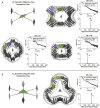Generation of ordered protein assemblies using rigid three-body fusion
- PMID: 34074752
- PMCID: PMC8201882
- DOI: 10.1073/pnas.2015037118
Generation of ordered protein assemblies using rigid three-body fusion
Abstract
Protein nanomaterial design is an emerging discipline with applications in medicine and beyond. A long-standing design approach uses genetic fusion to join protein homo-oligomer subunits via α-helical linkers to form more complex symmetric assemblies, but this method is hampered by linker flexibility and a dearth of geometric solutions. Here, we describe a general computational method for rigidly fusing homo-oligomer and spacer building blocks to generate user-defined architectures that generates far more geometric solutions than previous approaches. The fusion junctions are then optimized using Rosetta to minimize flexibility. We apply this method to design and test 92 dihedral symmetric protein assemblies using a set of designed homodimers and repeat protein building blocks. Experimental validation by native mass spectrometry, small-angle X-ray scattering, and negative-stain single-particle electron microscopy confirms the assembly states for 11 designs. Most of these assemblies are constructed from designed ankyrin repeat proteins (DARPins), held in place on one end by α-helical fusion and on the other by a designed homodimer interface, and we explored their use for cryogenic electron microscopy (cryo-EM) structure determination by incorporating DARPin variants selected to bind targets of interest. Although the target resolution was limited by preferred orientation effects and small scaffold size, we found that the dual anchoring strategy reduced the flexibility of the target-DARPIN complex with respect to the overall assembly, suggesting that multipoint anchoring of binding domains could contribute to cryo-EM structure determination of small proteins.
Keywords: DARPin; cryo-EM; nanomaterials; protein design; protein fusion.
Conflict of interest statement
The authors declare no competing interest.
Figures





Similar articles
-
Fusion of DARPin to Aldolase Enables Visualization of Small Protein by Cryo-EM.Structure. 2019 Jul 2;27(7):1148-1155.e3. doi: 10.1016/j.str.2019.04.003. Epub 2019 May 9. Structure. 2019. PMID: 31080120 Free PMC article.
-
A large, general and modular DARPin-apoferritin scaffold enables the visualization of small proteins by cryo-EM.IUCrJ. 2025 May 1;12(Pt 3):393-402. doi: 10.1107/S2052252525003021. IUCrJ. 2025. PMID: 40277178 Free PMC article.
-
DARPin-Based Crystallization Chaperones Exploit Molecular Geometry as a Screening Dimension in Protein Crystallography.J Mol Biol. 2016 Apr 24;428(8):1574-88. doi: 10.1016/j.jmb.2016.03.002. Epub 2016 Mar 11. J Mol Biol. 2016. PMID: 26975886
-
Design of helical linkers for fusion proteins and protein-based nanostructures.Methods Enzymol. 2021;647:209-230. doi: 10.1016/bs.mie.2020.10.003. Epub 2020 Nov 18. Methods Enzymol. 2021. PMID: 33482989 Review.
-
Chaperone-assisted structure elucidation with DARPins.Curr Opin Struct Biol. 2020 Feb;60:93-100. doi: 10.1016/j.sbi.2019.12.009. Epub 2020 Jan 6. Curr Opin Struct Biol. 2020. PMID: 31918361 Review.
Cited by
-
Antigen spacing on protein nanoparticles influences antibody responses to vaccination.bioRxiv [Preprint]. 2023 May 24:2023.05.23.541980. doi: 10.1101/2023.05.23.541980. bioRxiv. 2023. Update in: Cell Rep. 2023 Dec 26;42(12):113552. doi: 10.1016/j.celrep.2023.113552. PMID: 37292995 Free PMC article. Updated. Preprint.
-
A designed ankyrin-repeat protein that targets Parkinson's disease-associated LRRK2.J Biol Chem. 2024 Jul;300(7):107469. doi: 10.1016/j.jbc.2024.107469. Epub 2024 Jun 12. J Biol Chem. 2024. PMID: 38876305 Free PMC article.
-
Designed proteins assemble antibodies into modular nanocages.Science. 2021 Apr 2;372(6537):eabd9994. doi: 10.1126/science.abd9994. Science. 2021. PMID: 33795432 Free PMC article.
-
Crystal structure of human serum albumin in complex with megabody reveals unique human and murine cross-reactive binding site.Protein Sci. 2024 Feb;33(2):e4887. doi: 10.1002/pro.4887. Protein Sci. 2024. PMID: 38152025 Free PMC article.
-
Cryo-EM structure determination of small therapeutic protein targets at 3 Å-resolution using a rigid imaging scaffold.Proc Natl Acad Sci U S A. 2023 Sep 12;120(37):e2305494120. doi: 10.1073/pnas.2305494120. Epub 2023 Sep 5. Proc Natl Acad Sci U S A. 2023. PMID: 37669364 Free PMC article.
References
Publication types
MeSH terms
Substances
Grants and funding
LinkOut - more resources
Full Text Sources
Other Literature Sources

